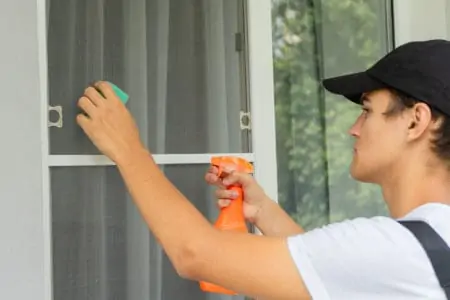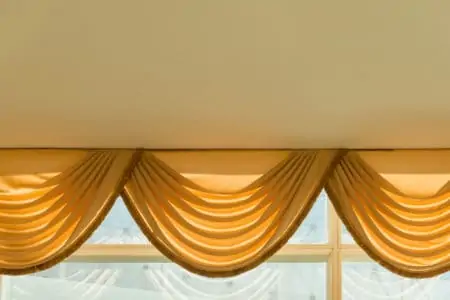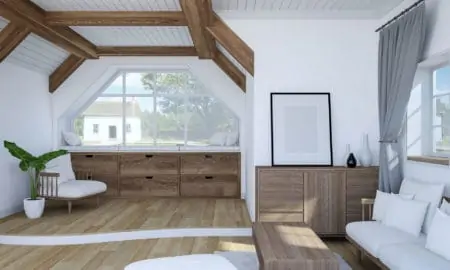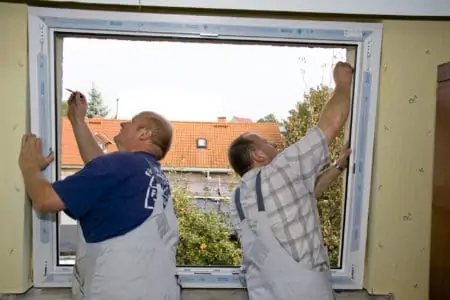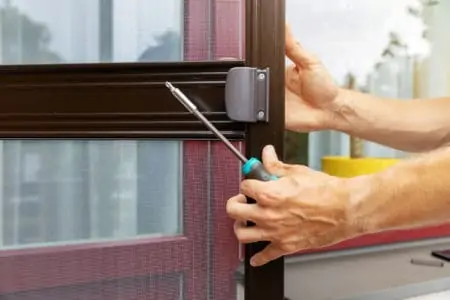“I can’t wait to clean those window screens,” said no one ever! Window screen cleaning is not the most glamorous of tasks, but it is necessary. Keeping them clean improves the airflow inside your home and enhances your view outside.
We show you how to clean window screens, along with cheats and hacks that make the process much simpler.
Key Takeaways
- Window screens need regular cleaning to improve airflow and maintain a clear view outside.
- Use a pressure washer, vinegar solution, or vacuum cleaner to clean window screens effectively.
- Cleaning window screens without removing them can be done with a magic eraser or lint brush.
- Weekly dust removal and using vinegar can help keep window screens clean and reduce cleaning time.
Do Window Screens Need to be Cleaned?
Dirty screens are unsightly from the outside and inside. The screen is supposed to protect your home against bugs, but when it obscures the view because of dirt, it’s time to clean. Your window screen is also supposed to improve airflow, but it can’t if it is blocked with grime.
Maintenance is crucial if you value your window screens and want them to last the recommended 10 to 15 years. And regular cleaning is a vital part of that regime.
Keep In Mind
Plus, while you have the screens down, it’s a good idea to inspect them for gaps and splits. If critters get into your house, it defeats the point of the window screen.
3 Ways to Clean Window Screens Easily
Cleaning your window screens doesn’t have to be a chore (who are we kidding?). Okay, it’s still about as much fun as slapping yourself in the face with a wet fish. However, at least it is easier using these methods.
With a Pressure Washer
If your screens are filthy or you‘re cleaning without removing them, using a pressure washer is an effective method.
The key is not to apply too much pressure in one spot, which risks damaging the screen (or worse, your window). To minimize this, put your pressure washer on a low-pressure setting.
What You’ll Need
- Pressure washer.
- Soapy water.
- Bucket.
- Scrubbing brush (for ground floor screens).
- Garden hose.
- Water source.
- Attach the pressure washer to the water source with the garden hose.
- Ensure you use a 40-degree tip to avoid blasting the screen with a direct hit of water.
- Turn on the faucet and the pressure washer.
- Direct the spray at the screen, ensuring you keep it at a 40-degree angle.
- Work across the screen in sweeping motions, working up and down or side to side.
- Turn off the pressure washer when the screen is completed.
- For lower floor screens, grab the bucket and fill it with soapy water. Use the scrubbing brush to remove any stubborn dusty spots.
With Vinegar
Vinegar isn’t just for pickling onions; it has a multitude of uses around the home. Cleaning your screens with vinegar is a cost-effective and environmentally friendly way to complete the task.
It is best to do this task on a sunny day to allow the screens to dry out.
What You’ll Need
- Bucket.
- Dish soap and water.
- Sponge.
- Vacuum cleaner.
- Hose.
- Remove the screens and lay them on the grass. If you have many screens, think about labeling each one, so you know which window they belong to.
- Mix a quarter of a cup of vinegar with half a gallon of water in the bucket. You can also use soapy water instead of vinegar.
- Hold the screen upright and wash it down with the vinegar and water solution.
- Hose the screen down before the vinegar solution dries.
- Now lay the screens to dry in the sunlight for a few hours.
- Use the vacuum cleaner with the soft brush attachment to remove any last remnants of dust. Now the screens are ready to reinstall.
With a Vacuum Cleaner
If your screens are lightly stained with dirt, a vacuum cleaner is an ideal solution. It is the easiest way of keeping your ground floor screens clean while still in place. It also works well when you are cleaning your screens from indoors.
You will need to vacuum more regularly because this method only works on light dust.
What You’ll Need
- Dropcloth.
- Vacuum cleaner.
- Soft brush attachment.
- For the best results, remove the screens and lay them on a dropcloth.
- Attach the soft brush attachment and switch the vacuum on.
- Run the brush over the screen to remove the dust.
- When the dust is gone, reinstall the screen.
How to Clean Window Screens Without Removing Them
Some metal screens are heavy to lift, so cleaning them from indoors is much more convenient. While aluminum screens are lighter, you still have to remove them, and that’s a hassle. Removing the screens slows the process, so keeping them in situ makes everything easier.
With Magic Eraser
With magic erasers, like this pack of Mr. Clean Extra Durable Erasers, you can get into the gaps between the mesh and remove stubborn grime. Magic erasers are very useful when it comes to screen cleaning.
We recommend using the extra durable erasers because they withstand greater punishment and last longer.
What You’ll Need
- Magic erasers.
- A bucket.
- Clean water.
- A dry rag.
- Wet the magic eraser and gently rub it over the surface of the screen. Use circular motions to get into all the gaps.
- Don’t apply too much pressure, or you risk the mesh stretching.
- When clean, wipe the screen with the dry rag to remove the last residues of dirt.
With a Lint Brush
Lint rollers are useful for removing very light dust from your window screens. If you have filthy screens, consider using another method. The great thing about lint rollers is they are super convenient and easy to use.
What You’ll Need
- Lint roller.
- Hand brush.
- Toothbrush.
- Loosen the larger dust particles with a brush to enable the lint roller to pick up more debris.
- Run the lint roller over the surface, making sure you cover the entire screen. You may need to peel off another roller layer to ensure it keeps picking up the dirt.
- For stubborn dust, try using a toothbrush to get into smaller gaps.
How to Reattach a Window Screen
Okay, so you got the screen down, but now you have to get it reattached. Most window screens have either tabs, pins, or clips on the sides or top. We will reattach a screen with the clips on the top and two springs on the base for this example.
Push the screen into the track, applying gentle downward pressure on the springs. At the same time, push the top section of the screen forward so it fits into the frame. Pull the clips down, so they are retracted when the top part of the frame sits snugly in the track.
Simply release the tabs to lock the screen in place.
Window Screen Cleaning Hacks
Cleaning window screens is about as much fun as root canal work, so anything that makes it less of a chore is always welcome. Knowing the tips and tricks makes it a much smoother and more enjoyable process.
Remove Dust Every Week
While you might not think you have the time to do this, the alternative is dedicating an entire cleaning day to get the screens clean. Doing a little bit more often reduces the dust buildup and makes it easier to get the job done.
Run the vacuum with the soft brush attachment over the screen once a week. Using the vacuum once a week also means the screens can be cleaned from the inside.
Keep Vinegar Handy
Keep a spray bottle of vinegar and water handy so that you can spray the screen down every week to keep dirt at bay. You could combine this with the vacuum cleaner once the vinegar solution has dried.
Fit Self-Cleaning Screens
Self-cleaning screens are typically made from high-tensile steel and steel mesh and are ideal when the screen is hard to get to. They reduce anti-clogging and increase the wear life of the screen.
While self-cleaning screens are better than standard models, they do still need cleaning, just less often. They also cost more than other window screens, so decide if the initial outlay is worth it before you buy.
FAQs
Clean Your Screen
Window screens keep out bugs and increase the airflow inside your home. Letting your screens get dirty reduces that airflow and blocks your view outside. Cleaning screens is not the most enjoyable task, but it is a necessary one.
Luckily, you don’t need any specific skills to keep your window screen clean, and if you do it weekly, it should be a quick job.
